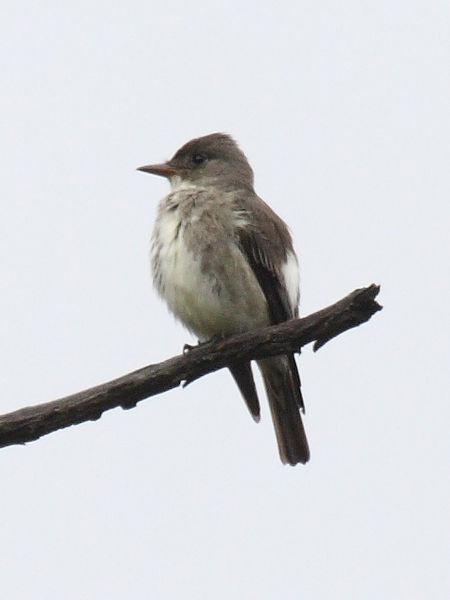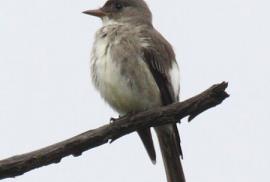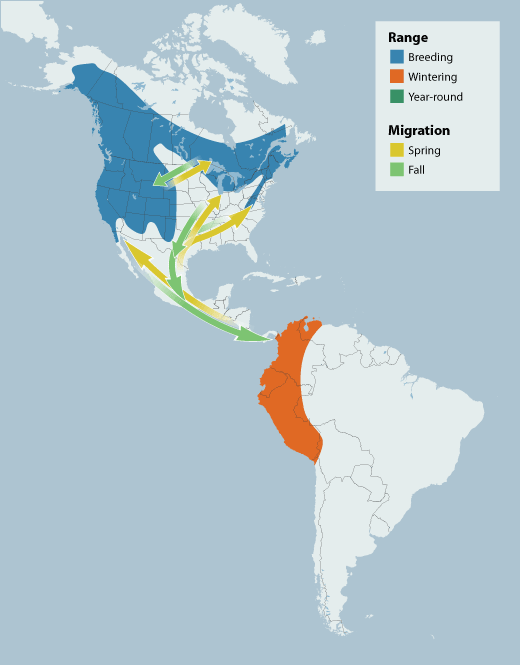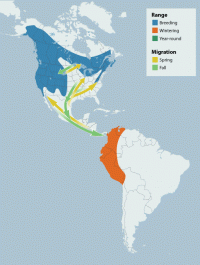Guide to Boreal Birds
This is an in-depth boreal species profile.
What is this?
This species is one of more than 30 birds selected for in-depth profiles. Find out why and see all selected boreal birds »
Overview
The Olive-sided Flycatcher is an unfamiliar bird to most people and perhaps best known among birders for its distinctive song, typically rendered as, "Quick, three beers!" Despite its relative obscurity, however, this congener of the pewees is a characteristic breeding species of the boreal region and western coniferous forests and is one of the most abundant birds in the heart of its winter range. It has the longest migration of any North American flycatcher; birds nesting in Alaska may winter as far south as Bolivia. Olive-sided Flycatchers are found in forest openings and edges near natural meadows, wetlands, canyons and rivers throughout the boreal forest and appear to be closely linked to natural disturbances such as fire. It is declining range-wide and little was known about its ecology until several recent, focused studies revealed previously unknown aspects of its breeding habits.
Description
7 1/2" (19 cm). A large-billed and heavy-headed bird, deep olive-brown, with dark sides of breast and flanks separated by white patch down center of breast. White feather tufts protrude from lower back at base of tail; tail broad and prominently notched. See Greater Pewee.
Voice
Song a distinctive and emphatic quick-three-beers; call a loud pip-pip-pip.
Nesting
3 brown-spotted buff eggs in a twig nest lined with lichens, mosses, and grasses, placed near the end of a branch among the foliage well up in an evergreen tree.
Habitat
On the breeding grounds, the Olive-sided Flycatcher is strongly associated with openings and edges in coniferous forest habitats. Thus, it responds favorably to logging and fires if sufficient snags and residual trees remain to provide foraging and singing perches. In fire-dependent ecosystems such as inland pine forests, it is one of a suite of species that occur at higher densities in burned than unburned areas; in moist, coastal forests, it is sometimes the only forest species thus distributed. In some areas it is even a burn obligate. It also is frequently found along stream-courses and shorelines, where natural edges occur and insect densities are high. In the boreal zone, it is most common in open spruce and tamarack muskeg, bogs, and swamps. On migration it increases its use of riparian and non-coniferous habitats, primarily in mountains. Its preferred winter habitat is mature, mid-elevation, evergreen forest, especially openings and edges as on the breeding grounds.
Range/Migration
Fall migration begins as early as late July, probably by failed breeders, and all have left the breeding grounds by October. This species is generally solitary and inconspicuous in migration. Most populations migrate through the mountains of western North America and Mexico, with small numbers traversing the Midwest to Texas and a few crossing the Gulf of Mexico. The vast majority winters in Panama and the northern Andes from northern Venezuela to western Bolivia, with the highest densities in Colombia. Small numbers winter east across the northern Amazon basin and north to western Mexico. The first birds appear on the winter grounds in late August and depart in mid-March; even fewer turn up in the eastern U.S. in spring than in fall.
Breeding
The breeding grounds of the Olive-sided Flycatcher extend from western Alaska clear across the Nearctic boreal zone to eastern Canada and northern New England. They also extend south through the western mountains to central California, Arizona, and New Mexico. Small, disjunct breeding populations occur in the South Coast and Peninsular Ranges of southern California and northern Baja California; the Spring Mountains of southern Nevada; the Guadalupes of west Texas; and the Smokies, Blue Ridge, Catskills, and Berkshires. This is one of the latest nesters of all North American breeding birds. Males arrive first on the breeding grounds, beginning in late April (in the south), and pairs form over a period of up to two weeks as the females arrive shortly thereafter. Breeding territories are quite large, perhaps contributing to an observed low incidence of polygamy. Nests are usually placed on outer reaches of branches in dense clusters of twigs and needles high in conifers. Most nest building occurs from mid-May to mid-June; the peak of egg laying is mid-June to early July, and incubation of the 3-4 eggs lasts about two weeks. Young may fledge as late as early September, especially in cases of re-nesting after nest failure. Females do all the incubation and brooding; males provide food for the female and both parents feed the young. There is only one brood per year, and overall annual productivity of this species is among the lowest of any North American songbird. Nest success rates in an Oregon study were highest in burns and lowest on forest edges.
Diet/Feeding Behavior
As far as is known, this species feeds almost entirely on flying insects, especially bees, wasps, and ants. Flies, moths, grasshoppers, dragonflies, and beetles also are taken; in some areas, such as the Sierra Nevada, and especially in burned forest, bark beetles may predominate in the diet. It feeds in typical flycatcher fashion, hunting passively from exposed perches and sallying out to capture prey in the air, often returning to the same perch; it is the only North American flycatcher to use this method exclusively. Snags are favored perches of this species, probably because they offer panoramic views. It consumes small prey in the air and carries larger prey back to the perch, where it bashes it against the perch to subdue it if necessary.
References
Altman, B. 1997. Olive-sided Flycatcher in western North America. Status review prepared for U.S. Fish and Wildl. Serv., Portland, OR.
Altman, B., and R. Sallabanks. 2000. Olive-sided Flycatcher (Contopus cooperi). In The Birds of North America, No. 502 (A. Poole and F. Gill, eds.). The Academy of Natural Sciences, Philadelphia, and The American Ornithologists' Union, Washington, D.C.
Fitzpatrick, J. W. 1980. Wintering of North American tyrant flycatchers in the Neotropics. Pp. 67-78 in Migrant birds in the Neotropics: ecology, behavior, distribution, and conservation (A. Keast and E. S. Morton, eds.). Smithson. Inst. Press, Washington, D.C.
Kotliar, N. B., and C. P. Melcher. 1997. Habitat selection and nesting success of Olive-sided Flycatchers under natural and managed disturbance regimes. Unpubl. annual report. U.S. Fish and Wildl. Serv., U.S. Geol. Surv. – Biol. Resour. Div., Fort Collins, CO.
Murphy, M. T. 1989. Life history variability in North American breeding tyrant flycatchers: phylogeny, size or ecology. Oikos 54:3-14.
Sauer, J. R., J. E. Hines, and J. Fallon. 2004. The North American Breeding Bird Survey, Results and Analysis 1966 - 2003. Version 2004.1. USGS Patuxent Wildlife Research Center, Laurel, MD.
Credits
Birding content provided by National Wildlife Federation/eNature, with support from Ducks Unlimited/The Pew Charitable Trusts.





